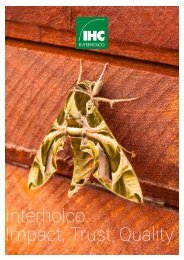Nomenclature Générale des Bois Tropicaux - 7ème édition
(english description below) Cette nomenclature est utilisée pour la mise à jour du 'Harmonized Code System' de l’Organisation Mondiale des Douanes. Dans la circulaire du 5 avril 2005, le Ministère de l’Economie, des Finances et de l’Industrie (France) reconnaît l’ATIBT comme « gardien du temple » de la nomenclature des bois tropicaux. La Commission Européenne mentionne la nomenclature de l’ATIBT comme document de référence pour la mise en œuvre du RBUE. Depuis 1954, l’ATIBT a établi et mis à jour une nomenclature des bois tropicaux faisant correspondre chaque espèce botanique avec un nom pilote reconnu internationalement. La détermination du nom pilote d’une essence est cruciale, car sa commercialisation dépend très largement de l’adoption de ce nom par le public. Le nom pilote assure la protection de l’appellation commerciale de l’essence et l’intégrité des propriétés qui lui sont attribuées, sans risque de confusion. The 1982 version of the general timber nomenclature has finally been updated as some of the 1,750 identified species, are no longer traded, while others, which were not previously included, are now on the market. The present revision has also integrated changes related to new taxonomy, in order to reflect the latest scientific developments. This Nomenclature has been used for the Harmonized Code System, updated by the World Customs Organization. The French Ministry of economy, finance and industry has given official recognition to ATIBT as the reference for the tropical timber nomenclature (NOR: PRMX0508285C of April 5th 2005). The European Commission refers to ATIBT nomenclature as a reference document for the implementation of the EUTR regulation. Since 1954, ATIBT has established and updated a nomenclature of tropical wood, linking each botanical species with an internationally recognized pilot name. A sigle wood species may have many common names; when trading across different countries, this may lead to confusion. Fixing the pilot name of a timber species is crucial, to protect the commercial denomination of the species and guarantee the veracity of the properties linked to that species, without confusion.
(english description below)
Cette nomenclature est utilisée pour la mise à jour du 'Harmonized Code System' de l’Organisation Mondiale des Douanes. Dans la circulaire du 5 avril 2005, le Ministère de l’Economie, des Finances et de l’Industrie (France) reconnaît l’ATIBT comme « gardien du temple » de la nomenclature des bois tropicaux. La Commission Européenne mentionne la nomenclature de l’ATIBT comme document de référence pour la mise en œuvre du RBUE.
Depuis 1954, l’ATIBT a établi et mis à jour une nomenclature des bois tropicaux faisant correspondre chaque espèce botanique avec un nom pilote reconnu internationalement. La détermination du nom pilote d’une essence est cruciale, car sa commercialisation dépend très largement de l’adoption de ce nom par le public. Le nom pilote assure la protection de l’appellation commerciale de l’essence et l’intégrité des propriétés qui lui sont attribuées, sans risque de confusion.
The 1982 version of the general timber nomenclature has finally been updated as some of the 1,750 identified species, are no longer traded, while others, which were not previously included, are now on the market. The present revision has also integrated changes related to new taxonomy, in order to reflect the latest scientific developments.
This Nomenclature has been used for the Harmonized Code System, updated by the World Customs Organization. The French Ministry of economy, finance and industry has given official recognition to ATIBT as the reference for the tropical timber nomenclature (NOR: PRMX0508285C of April 5th 2005). The European Commission refers to ATIBT nomenclature as a reference document for the implementation of the EUTR regulation.
Since 1954, ATIBT has established and updated a nomenclature of tropical wood, linking each botanical species with an internationally recognized pilot name. A sigle wood species may have many common names; when trading across different countries, this may lead to confusion. Fixing the pilot name of a timber species is crucial, to protect the commercial denomination of the species and guarantee the veracity of the properties linked to that species, without confusion.
You also want an ePaper? Increase the reach of your titles
YUMPU automatically turns print PDFs into web optimized ePapers that Google loves.
Liste des noms vernaculaires avec renvoi au nom pilote /// 101
NOMS VERNA-
CULAIRES
COMMON
NAMES
PAYS
COUNTRY
Caniva PA Copaiba
NOM PILOTE
PILOT NAME
Canon Ball GY Couroupita
Caoba EC Macacaúba
Caoba BO Mahogany
Caoba CO Mahogany
Caoba PE Mahogany
Caoba VE Mahogany
Caoba CU Mahogany
Caoba del Galon GQ Acajou d’Afrique
Caoî VN Berangan
Caovi BR Timborana
Cap Box ZA Boxwood
Capa de tabaco VE Tauari
Caparrapi CO Comino
Capinuri PE Guariúba
Capinuri BR Muiratinga
Capirona BR Pau mulato
Capirona PE Pau mulato
Capomo BR Capomo
Caporococa BR Canelón
Capricornia PE Cupiuba
Caracoli CO Caju açu
Caracoli VE Caju açu
Caraipé BR Grigri
Carano BO Kurokaï
Carano CO Kurokaï
Carano VE Kurokaï
Carapa BR Andiroba
Carapa GF Andiroba
Carapa VE Andiroba
Carapanaúba BR Carreto
Carbonero PE Grigri
Carbonero VE Grigri
Carbonero CO Grigri
Cardeiro BR Cardeiro
Caribbean Pine US Pitch Pine
Caribbean
Rosewood
BZ Checham
Carito CO Tamboril
Caroba BR Parapará
Caroba do mato BR Parapará
Caro-Caro VE Tamboril
NOMS VERNA-
CULAIRES
COMMON
NAMES
PAYS
COUNTRY
Carrapatinho BR Panacoco
Carreto BR Carreto
Carreto CO Carreto
Carreto VE Carreto
Cartàn VE Araribà
NOM PILOTE
PILOT NAME
Carvalho BR Catucaém
Casca BR Casca
Cascaron VE Faveira
Castaña CO Castanheiro
Castana do Maranhao
Castanha de macaco
CO
BR
Castanheiro
Couroupita
Castanha de paca BR Cardeiro
Castanha do Brasil BR Castanheiro
Castanha do Brasil CO Castanheiro
Castanha do Para BR Castanheiro
Castanha do Para CO Castanheiro
Castanha Sapucaia BR Sapucaia
Castanheiro BR Castanheiro
Castaño CO Cardeiro
Casuarina AU Beefwood
Catahua PE Açacu
Catalpa GF Milo
Catiguà AR Catiguà
Catillo NI Balsa
Cativo CO Cativo
Cativo CR Cativo
Cativo PA Cativo
Catucaém BR Catucaém
Caviúna
BR
Rosewood, Caviuna
Caviuna legitima BR Rosewood, Rio
Caxinguba BR Caxinguba
Cebil AR Curupay
Cebil blanco AR Curupay-ra
Cedar, East African ZA Cedar, East African
Ceder SR Cedro
Cedrat GF Cedro
Cèdre apici GF Louro branco
Cedre Remi GF Tachi
Cedrinho BR Cambara
Cedrinho BR Cardeiro














